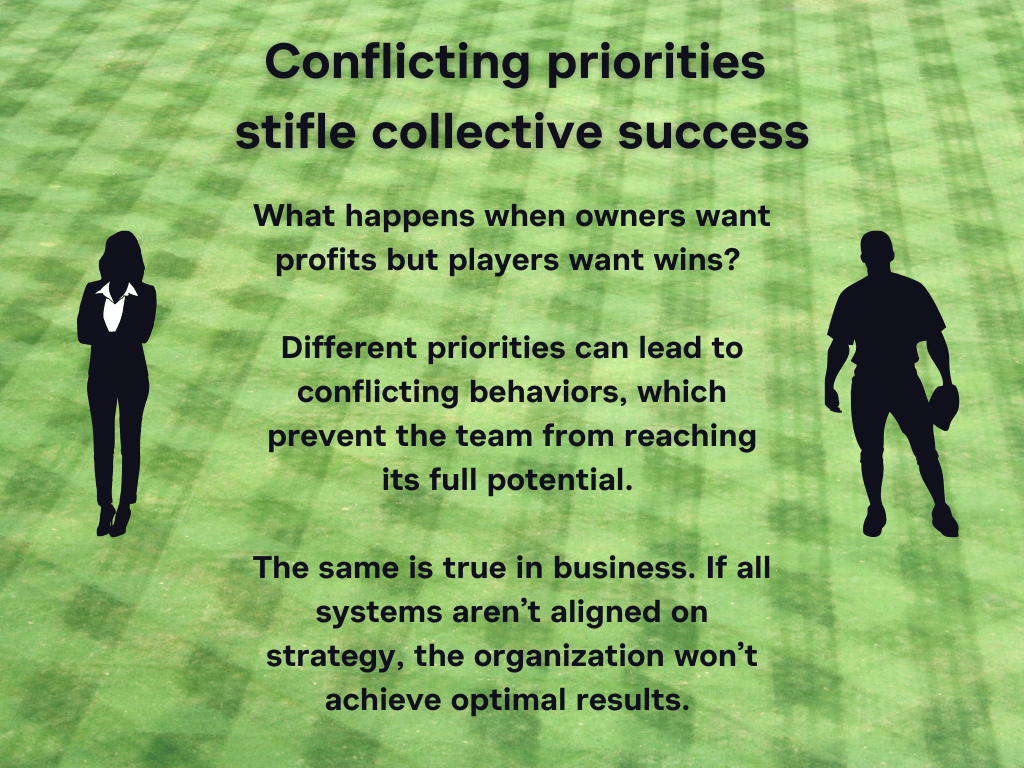For me, growing up immersed in sports has always been a rollercoaster of emotions—moments of elation and despair that mirror the highs and lows felt by countless others. Our favorite teams have a remarkable ability to stir deep emotions. We engage in daily conversations about how our teams could improve, emphasizing their problems and providing our perspective on how they could achieve better results. (Something my partner might say takes up too much of my daily conversations…)
In this blog, I aim to have some fun applying my perspective as a systems thinker and organization design practitioner. With this blog, I hope to inspire organizational leaders to rethink their approach to achieving successful results—or at the very least, give you some fresh ideas for those sports conversations at the office or neighborhood pub.
How Do We Measure Success?
At first glance, success in sports might seem easy to define—most would say it’s all about winning, right? Just like in business, where the goal is simply to make money? Well, as any good consultant would say, it depends. Success in sports, like in organizations, is multifaceted. It depends on the sport, the organization, the circumstances and most importantly, who you ask. There are countless ways to measure success, and perspectives vary greatly.
What Can We Learn from the A’s?
Let’s examine the Oakland A’s baseball team. Like every professional sports team, they have players, coaches, executives and an owner. In recent history, the A’s haven’t won a championship, made the playoffs, or even had many winning seasons. Ask any fan of the team—or even just baseball in general—and they’ll tell you the results have been far from successful, especially as the team is now on the verge of relocating to a different city. But for the owner, who has seen the team’s profitability and market value rise, these results might be viewed as a success. There’s more to say there but for the sake of any A’s fans reading, I will digress.
If the primary goal is financial gain, then perhaps the A’s are hitting their mark. If you ask the players, you’d likely get a mix of responses. While the team hasn’t found collective success, individual players may still thrive—earning accolades and contracts that could boost their careers and earnings, whether with the A’s or another team. Would they prefer to win a championship? Of course. But different people in the same organization often have differing priorities, leading to behaviors that can conflict with one another. This lack of alignment can stifle collective success. We often see the same behaviors in organizations, where competing goals can cause internal friction and prevent the team from reaching its full potential.

Taking a Systems Alignment Approach to Change Results
The reality is that every organization is perfectly designed to achieve the results it’s getting right now. If you want different results, the organization must change. Yet, all too often in sports and in business, the reaction to poor results is to make piecemeal changes. We tweak a few aspects here and there, rather than taking a holistic, systems-oriented approach.
A common example is the reflex to adjust organizational structure—moving boxes around on a chart, bringing in new talent—without addressing the underlying systems. As many of us have experienced, these quick fixes rarely yield the desired results. Meaningful change requires aligning multiple systems within the organization, all working toward a shared strategy for success. We call this holistic approach “systems thinking.” Systems thinking focuses on understanding how various parts of an organization work together and influence each other.
High-Level Systems Approach
Diagnose the System Environment:
The first step in any change process is understanding your current state. If you want better results, you need a comprehensive view of your team’s strengths, weaknesses, and the systems at play. Assessing multiple facets of the organization prevents imprudent decisions. In sports, we often see teams pin the blame on specific players after a disappointing season. In reality, many factors likely contributed to the failure.
Define Success and Set a Clear Strategy to Win:
Success needs to be clearly defined and specific—more than just “make more money” or “win a championship.” Establishing clear goals and setting guardrails for change ensures alignment on what the end state should look like. This must then be supported by a well-defined strategy that outlines how you’ll differentiate yourself and compete to achieve your goals. The strategy must set a clear direction that articulates how you intend to deliver value in a superior way.
Prioritize Strategic Capabilities and Align System Choices:
The next step is to prioritize the capabilities your team or organization needs to achieve the strategy. What are the essential strengths that will drive success? Do you focus more on offense or defense? On recruitment or talent development? While it would be ideal to excel in all areas, it’s critical to focus on what aligns best with your strategy.
Once these capabilities are prioritized, you can start making choices about the systems that support them. For a sports team, this might include the player talent, compensation structures or even the quality of the facilities and many other various systems. In a broader organizational context, we use the organizational cube model, which encompasses six major systems: work, structure, information and metrics, leadership and culture, rewards and recognition and continuous alignment to describe some broader organizational systems. All systems in the organization should be aligned with your strategy if you want to see the results you’re aiming for.

Execution and Implementing Choices
It’s not enough to have a plan to win. Execution is where real change happens. In sports, a good game plan can only go so far—coaches still need to make sharp calls, players need to perform at their best and you can’t let your opponent outplay you. The same is true for businesses competing in a constantly shifting market. Stagnation is dangerous. As the market evolves, so must your strategy and execution. Constantly align your systems to meet new challenges and capitalize on opportunities.
In essence, individual talent is important, but it’s just one piece of a much larger puzzle. Successful teams and organizations emerge when multiple systems—leadership, strategy, talent, and culture—work in harmony. If any one part is out of sync, whether it’s a coaching strategy misaligned with players’ strengths or an individual underperforming relative to their potential, the entire organization feels the strain.
Win With Systems Thinking
By embracing a systems thinking approach, organizations can better align their strategies, navigate challenges, and improve their chances of achieving the results they seek. This holistic perspective not only brings out the best in every team member but also ensures that every element within the organization contributes to collective success.
While I don’t claim to be a professional sports analyst, I believe there’s a lot we all can learn from the intricacies of our favorite teams. After all, sports—like business—offers us a powerful lens through which to examine systems, strategy, and the pursuit of making it to the pinnacle of success.





